 | –≠–ª–µ–∫—Ç—Ä–æ–Ω–Ω—ã–π –∫–æ–º–ø–æ–Ω–µ–Ω—Ç: ADS-932MM | –°–∫–∞—á–∞—Ç—å:  PDF PDF  ZIP ZIP |
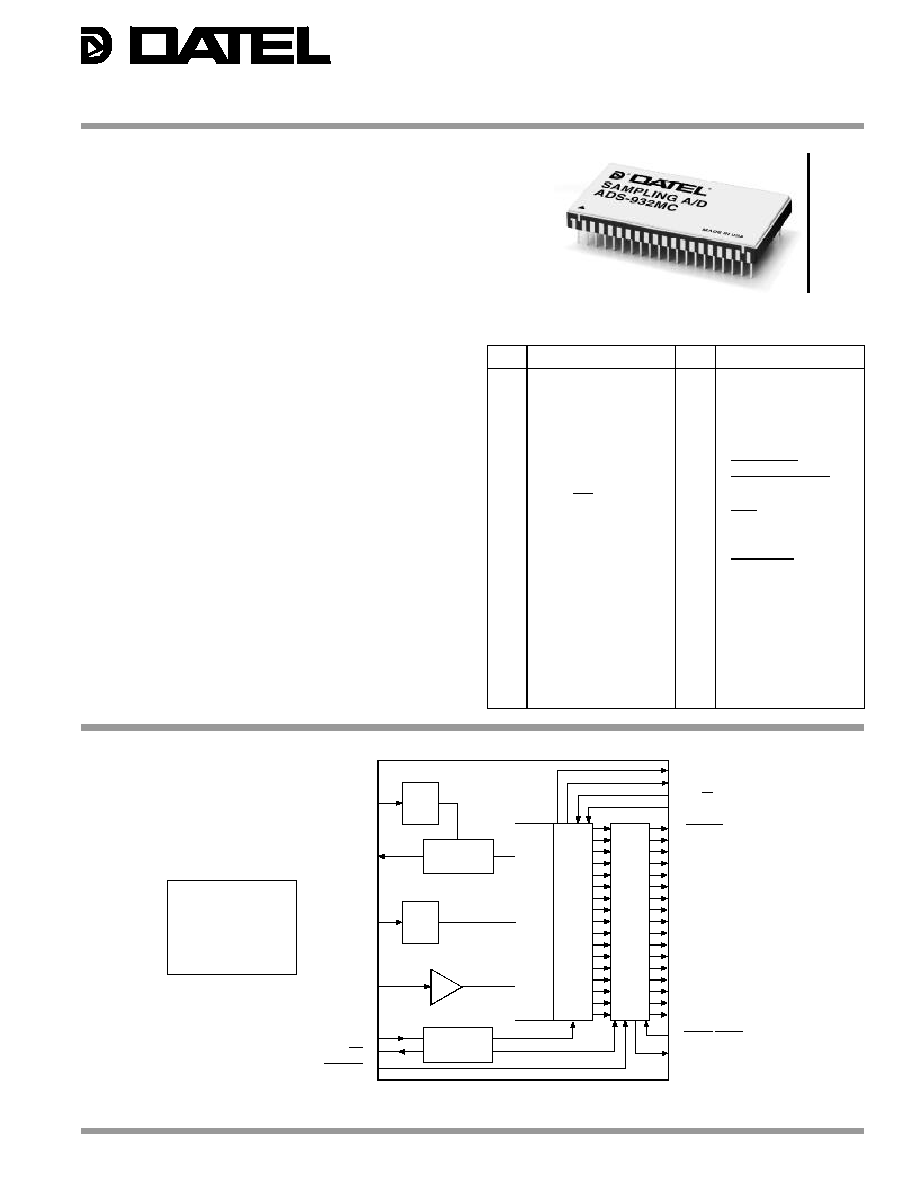
PIN
FUNCTION
PIN
FUNCTION
1
+3.2V REF. OUT
40
NO CONNECTION
2
UNIPOLAR
39
NO CONNECTION
3
ANALOG INPUT
38
+5V ANALOG SUPPLY
4
ANALOG GROUND
37
≠5V SUPPLY
5
OFFSET ADJUST
36
ANALOG GROUND
6
GAIN ADJUST
35
COMP. BITS
7
DIGITAL GROUND
34
OUTPUT ENABLE
8
FIFO/DIR
33
OVERFLOW
9
FIFO READ
32
EOC
10
FSTAT1
31
+5V DIGITAL SUPPLY
11
FSTAT2
30
DIGITAL GROUND
12
START CONVERT
29
BIT 1 (MSB)
13
BIT 16 (LSB)
28
BIT 1 (MSB)
14
BIT 15
27
BIT 2
15
BIT 14
26
BIT 3
16
BIT 13
25
BIT 4
17
BIT 12
24
BIT 5
18
BIT 11
23
BIT 6
19
BIT 10
22
BIT 7
20
BIT 9
21
BIT 8
FEATURES
∑
16-bit resolution
∑
2MHz sampling rate
∑
Functionally complete
∑
No missing codes over full military temperature range
∑
Edge-triggered
∑
±5V supplies, 1.85 Watts
∑
Small, 40-pin, ceramic TDIP
∑
87dB SNR, ≠88dB THD
∑
Ideal for both time and frequency-domain applications
16-Bit, 2MHz
Sampling A/D Converters
Æ
Æ
I N N O V A T I O N a n d E X C E L L E N C E
GENERAL DESCRIPTION
The low-cost ADS-932 is a 16-bit, 2MHz sampling A/D
converter. This device accurately samples full-scale input
signals up to Nyquist frequencies with no missing codes. The
dynamic performance of the ADS-932 has been optimized to
achieve a signal-to-noise ratio (SNR) of 87dB and a total
harmonic distortion (THD) of ≠88dB.
Packaged in a 40-pin TDIP, the functionally complete ADS-932
contains a fast-settling sample-hold amplifier, a subranging
(two-pass) A/D converter, an internal reference, timing/control
logic, and error-correction circuitry. Digital input and output
levels are TTL. The ADS-932 only requires the rising edge of
the start convert pulse to operate.
Requiring only ±5V supplies, the ADS-932 dissipates 1.85
Watts. The device is offered with a bipolar (±2.75V) analog
input range or a unipolar (0 to ≠5.5V) input range. Models are
available for use in either commercial (0 to +70∞C) or military
(≠55 to +125∞C) operating temperature ranges. A proprietary,
auto-calibrating, error-correcting circuit enables the device to
achieve specified performance over the full military
temperature range. Typical applications include medical
imaging, radar, sonar, communications and instrumentation.
INPUT/OUTPUT CONNECTIONS
ADS-932
DATEL, Inc., Mansfield, MA 02048 (USA)
∑
Tel: (508)339-3000, (800)233-2756 Fax: (508)339-6356
∑
E-mail:sales@datel.com
∑
Internet: www.datel.com
Figure 1. ADS-932 Functional Block Diagram
3-STATE
OUTPUT
REGISTER
29 BIT 1 (MSB)
28 BIT 1 (MSB)
27 BIT 2
26 BIT 3
25 BIT 4
24 BIT 5
23 BIT 6
22 BIT 7
21 BIT 8
20 BIT 9
19 BIT 10
18 BIT 11
17 BIT 12
16 BIT 13
15 BIT 14
14 BIT 15
13 BIT 16 (LSB)
TIMING AND
CONTROL LOGIC
GAIN ADJUST 6
+3.2V REF. OUT 1
OFFSET ADJUST 5
EOC 32
ANALOG GROUND 4, 36
DIGITAL GROUND 7, 30
+5V DIGITAL SUPPLY 31
≠5V SUPPLY 37
+5V ANALOG SUPPLY 38
NO CONNECTION 39, 40
CUSTOM GATE ARRAY
POWER and GROUNDING
2-PASS ANALOG-TO-DIGITAL CONVERTER
S/H
GAIN
ADJUST
CKT.
OFFSET
ADJUST
CKT.
PRECISION
+3.2V REFERENCE
ANALOG INPUT 3
START CONVERT 12
COMP. BITS 35
10 FSTAT1
11 FSTAT2
8 FIFO/DIR
9 FIFO/READ
34 OUTPUT ENABLE
33 OVERFLOW
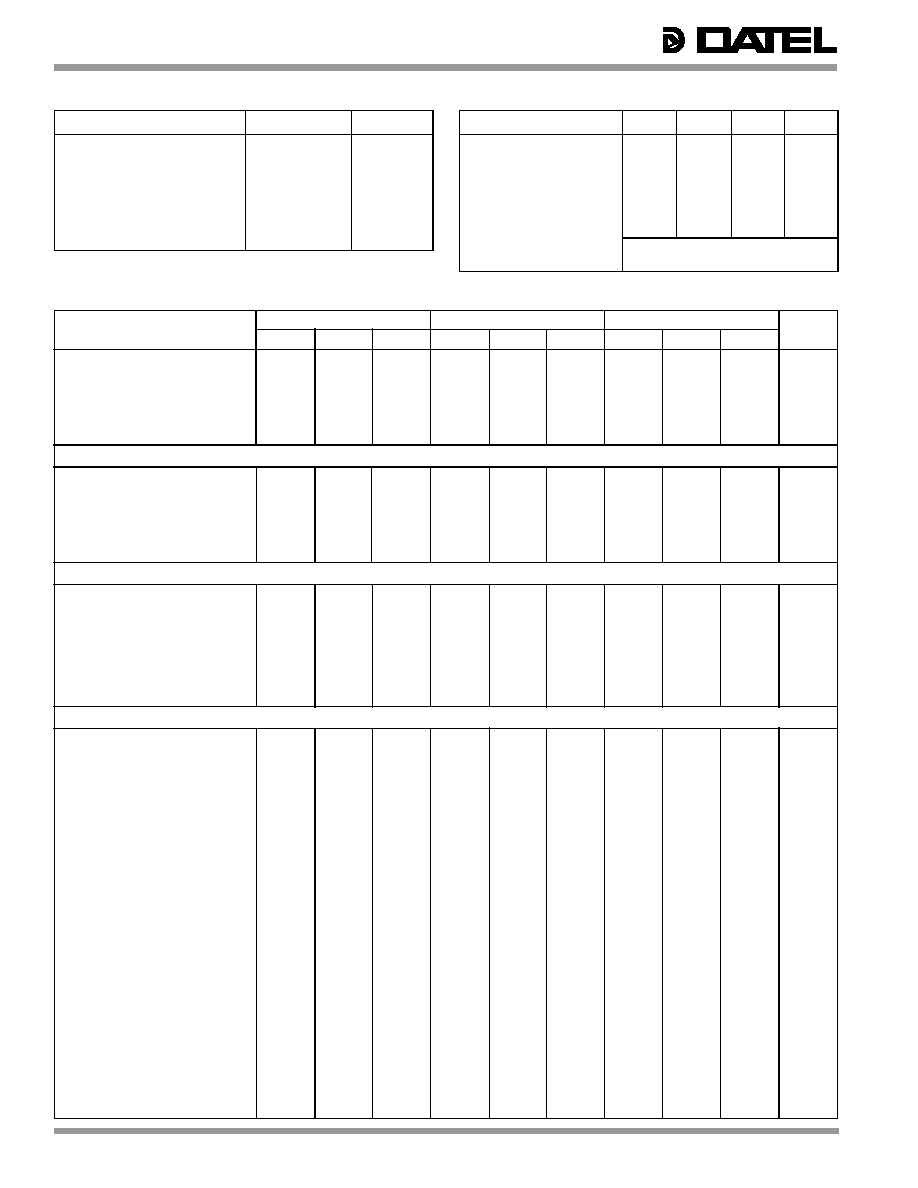
ADS-932
Æ
Æ
2
+25∞C
0 to +70∞C
≠55 to +125∞C
ANALOG INPUTS
MIN.
TYP.
MAX.
MIN.
TYP.
MAX.
MIN.
TYP.
MAX.
UNITS
Input Voltage Ranges
Unipolar
--
0 to ≠5.5
--
--
0 to ≠5.5
--
--
0 to ≠5.5
--
Volts
Bipolar
--
±2.75
--
--
±2.75
--
--
±2.75
--
Volts
Input Resistance (pin 3)
655
687
--
--
685
--
--
685
--
Input Resistance (pin 2)
418
426
--
--
400
--
--
400
--
Input Capacitance
--
10
15
--
10
15
--
10
15
pF
DIGITAL INPUTS
Logic Levels
Logic "1"
+2.0
--
--
+2.0
--
--
+2.0
--
--
Volts
Logic "0"
--
--
+0.8
--
--
+0.8
--
--
+0.8
Volts
Logic Loading "1"
--
--
+20
--
--
+20
--
--
+20
µA
Logic Loading "0"
--
--
≠20
--
--
≠20
--
--
≠20
µA
Start Convert Positive Pulse Width
40
250
--
40
250
--
40
250
--
ns
STATIC PERFORMANCE
Resolution
--
16
--
--
16
--
--
16
--
Bits
Integral Nonlinearity
--
±1
--
--
±1.5
--
--
±2
--
LSB
Differential Nonlinearity (f
in
= 10kHz)
≠0.95
±0.5
+1.0
≠0.95
±0.5
+1.0
≠0.95
±0.5
+1.5
LSB
Full Scale Absolute Accuracy
--
±0.1
±0.3
--
±0.15
±0.5
--
±0.5
±0.8
%FSR
Bipolar Zero Error (Tech Note 2)
--
±0.1
±0.2
--
±0.2
±0.4
--
±0.5
±0.9
%FSR
Bipolar Offset Error (Tech Note 2)
--
±0.1
±0.3
--
±0.2
±0.5
--
±0.4
±0.9
%FSR
Gain Error (Tech Note 2)
--
±0.1
±0.3
--
±0.15
±0.5
--
±0.5
±0.9
%
No Missing Codes (f
in
= 10kHz)
16
--
--
16
--
--
16
--
--
Bits
DYNAMIC PERFORMANCE
Peak Harmonics (≠0.5dB)
dc to 500kHz
--
≠90
≠81
--
≠90
≠81
--
≠88
≠80
dB
500kHz to 1MHz
--
≠90
≠81
--
≠90
≠81
--
≠88
≠80
dB
Total Harmonic Distortion (≠0.5dB)
dc to 500kHz
--
≠88
≠80
--
≠88
≠80
--
≠85
≠78
dB
500kHz to 1MHz
--
≠87
≠80
--
≠87
≠80
--
≠84
≠77
dB
Signal-to-Noise Ratio
(w/o distortion, ≠0.5dB)
dc to 500kHz
83
87
--
83
87
--
80
85
--
dB
500kHz to 1MHz
82
86
--
82
86
--
80
84
--
dB
Signal-to-Noise Ratio
(& distortion, ≠0.5dB)
dc to 500kHz
79
84
--
79
84
--
76
82
--
dB
500kHz to 1MHz
78
84
--
78
84
--
76
82
--
dB
Noise
--
83
--
--
83
--
--
83
--
µVrms
Two-Tone Intermodulation
Distortion (f
in
= 200kHz,
240kHz, f
s
= 2MHz, ≠0.5dB)
--
≠89
--
--
≠89
--
--
≠89
--
dB
Input Bandwidth (≠3dB)
Small Signal (≠20dB input)
--
7.8
--
--
7.8
--
--
7.8
--
MHz
Large Signal (≠0.5dB input)
--
7.1
--
--
7.1
--
--
7.1
--
MHz
Feedthrough Rejection
(f
in
= 1MHz)
--
90
--
--
90
--
--
90
--
dB
Slew Rate
--
±77
--
--
±77
--
--
±77
--
V/µs
Aperture Delay Time
--
+8
--
--
+8
--
--
+8
--
ns
Aperture Uncertainty
--
5
--
--
5
--
--
5
--
ps rms
S/H Acquisition Time
( to ±0.001%FSR, 5.5V step)
200
225
--
200
225
--
200
225
--
ns
PARAMETERS
MIN.
TYP.
MAX.
UNITS
Operating Temp. Range, Case
ADS-932MC
0
--
+70
∞C
ADS-932MM
≠55
--
+125
∞C
Thermal Impedance
jc
--
4
--
∞C/Watt
ca
--
18
--
∞C/Watt
Storage Temperature Range
≠65
--
+150
∞C
Package Type
40-pin, metal-sealed, ceramic TDIP
Weight
0.56 ounces (16 grams)
ABSOLUTE MAXIMUM RATINGS
PARAMETERS
LIMITS
UNITS
+5V Supply (Pins 31, 38)
0 to +6
Volts
≠5V Supply (Pin 37)
0 to ≠6
Volts
Digital Inputs (Pins 8, 9, 12, 34, 35)
≠0.3 to +V
DD
+0.3
Volts
Analog Input (Pin 3)
Volts
Bipolar
±5
Volts
Unipolar
≠10 to +5
Volts
Lead Temperature (10 seconds)
+300
∞C
PHYSICAL/ENVIRONMENTAL
FUNCTIONAL SPECIFICATIONS
(T
A
= +25∞C, ±V
CC
= ±5V, +V
DD
= +5V, 2MHz sampling rate, and a minimum 3 minute warm-up unless otherwise specified.)
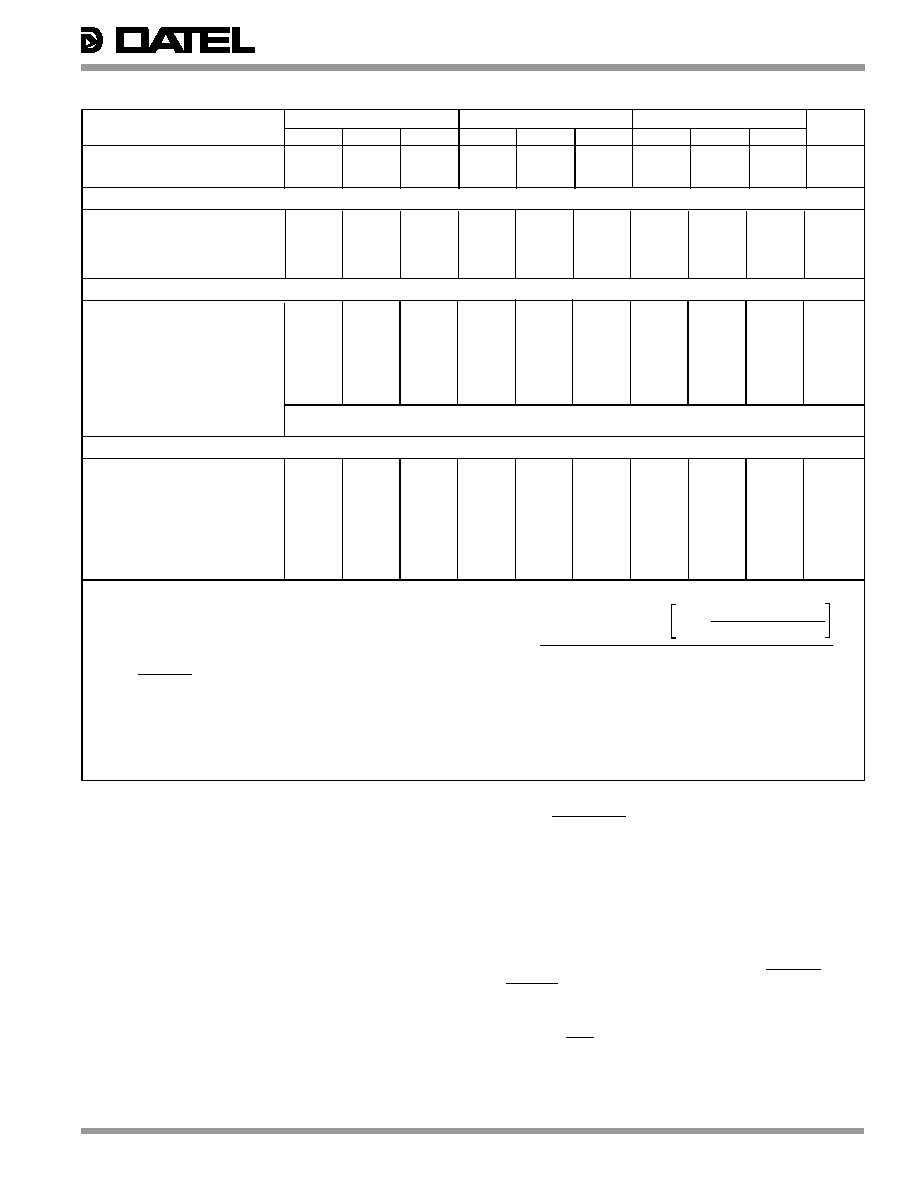
ADS-932
Æ
Æ
3
+25∞C
0 TO +70∞C
≠55 TO +125∞C
DYNAMIC PERFORMANCE
(Cont.)
MIN.
TYP.
MAX.
MIN.
TYP.
MAX.
MIN.
TYP.
MAX.
UNITS
Overvoltage Recovery Time
--
250
500
--
250
500
--
250
500
ns
A/D Conversion Rate
2
--
--
2
--
--
2
--
--
MHz
Footnotes:
Effective bits is equal to:
All power supplies must be on before applying a start convert pulse. All
supplies and the clock (START CONVERT) must be present during warm-up
periods. The device must be continuously converting during this time. There is
a slight degradation in performance when operating the device in the unipolar
mode.
When COMP. BITS (pin 35) is low, logic loading "0" will be ≠350µA.
A 1MHz clock with a positive pulse width is used for all production
testing. See Timing Diagram for more details.
40ns < Start Pulse < 175ns or 280ns < Start Pulse < 460ns
6.02
(SNR + Distortion) ≠ 1.76 + 20 log
Full Scale Amplitude
Actual Input Amplitude
This is the time required before the A/D output data is valid once the analog
input is back within the specified range. This time is only guaranteed if the input
does not exceed ±4.75V (bipolar)
or +2 to ≠7.5V (unipolar).
The minimum supply voltages of +4.9V and ≠4.9V for ±V
DD
are required for
≠55∞C operation only. The minimum limits are +4.75V and ≠4.75V when
operating at +125∞C.
TECHNICAL NOTES
1. Obtaining fully specified performance from the ADS-932
requires careful attention to pc-card layout and power supply
decoupling. The device's analog and digital ground systems
are connected to each other internally. For optimal perfor-
mance, tie all ground pins (4, 7, 30 and 36) directly to a
large analog ground plane beneath the package.
Bypass all power supplies and the +3.2V reference output to
ground with 4.7µF tantalum capacitors in parallel with 0.1µF
ceramic capacitors. Locate the bypass capacitors as close
to the unit as possible.
2. The ADS-932 achieves its specified accuracies without the
need for external calibration. If required, the device's small
initial offset and gain errors can be reduced to zero using
the adjustment circuitry shown in Figure 2. When using this
circuitry, or any similar offset and gain calibration hardware,
make adjustments following warm-up. To avoid interaction,
always adjust offset before gain. Tie pins 5 and 6 to
ANALOG GROUND (pin 4) if not using offset and gain adjust
circuits.
3. Pin 35 (COMP. BITS) is used to select the digital output
coding format of the ADS-932 (see Tables 2a and 2b).
When this pin has a TTL logic "0" applied, it complements
all of the ADS-932's digital outputs.
Pin 35 is TTL compatible and can be directly driven with
digital logic in applications requiring dynamic control over its
function. There is an internal pull-up resistor on pin 35
allowing it to be either connected to +5V or left open when a
logic "1" is required.
4. To enable the three-state outputs, connect OUTPUT
ENABLE (pin 34) to a logic "0" (low). To disable, connect pin
34 to a logic "1" (high).
5. Applying a start convert pulse while a conversion is in
progress (EOC = logic "1") will initiate a new and probably
inaccurate conversion cycle. Data from both the interrupted
and subsequent conversions will be invalid.
ANALOG OUTPUT
Internal Reference
Voltage
3.15
+3.2
3.25
3.15
+3.2
3.25
3.15
+3.2
3.25
Volts
Drift
--
±30
--
--
±30
--
--
±30
--
ppm/∞C
External Current
--
5
--
--
5
--
--
5
--
mA
DIGITAL OUTPUTS
Logic Levels
Logic "1"
+2.4
--
--
+2.4
--
--
+2.4
--
--
Volts
Logic "0"
--
--
+0.4
--
--
+0.4
--
--
+0.4
Volts
Logic Loading "1"
--
--
≠4
--
--
≠4
--
--
≠4
mA
Logic Loading "0"
--
--
+4
--
--
+4
--
--
+4
mA
Delay, Falling Edge of Enable to
Output Data Valid
--
--
10
--
--
10
--
--
10
ns
Output Coding
Straight Binary, Complementary Binary, Complementary Offset Binary,
Complementary Two's Complement, Offset Binary, Two's Complement
POWER REQUIREMENTS
Power Supply Ranges
+5V Supply
+4.75
+5.0
+5.25
+4.75
+5.0
+5.25
+4.9
+5.0
+5.25
Volts
≠5V Supply
≠4.75
≠5.0
≠5.25
≠4.75
≠5.0
≠5.25
≠4.9
≠5.0
≠5.25
Volts
Power Supply Currents
+5V Supply
--
+225
260
--
+225
260
--
+225
260
mA
≠5V Supply
≠140
≠135
--
≠140
≠135
--
≠140
≠135
--
mA
Power Dissipation
--
1.85
2.0
--
1.85
2.0
--
1.85
2.0
Watts
Power Supply Rejection
--
--
±0.07
--
--
±0.07
--
--
±0.07
%FSR/%V
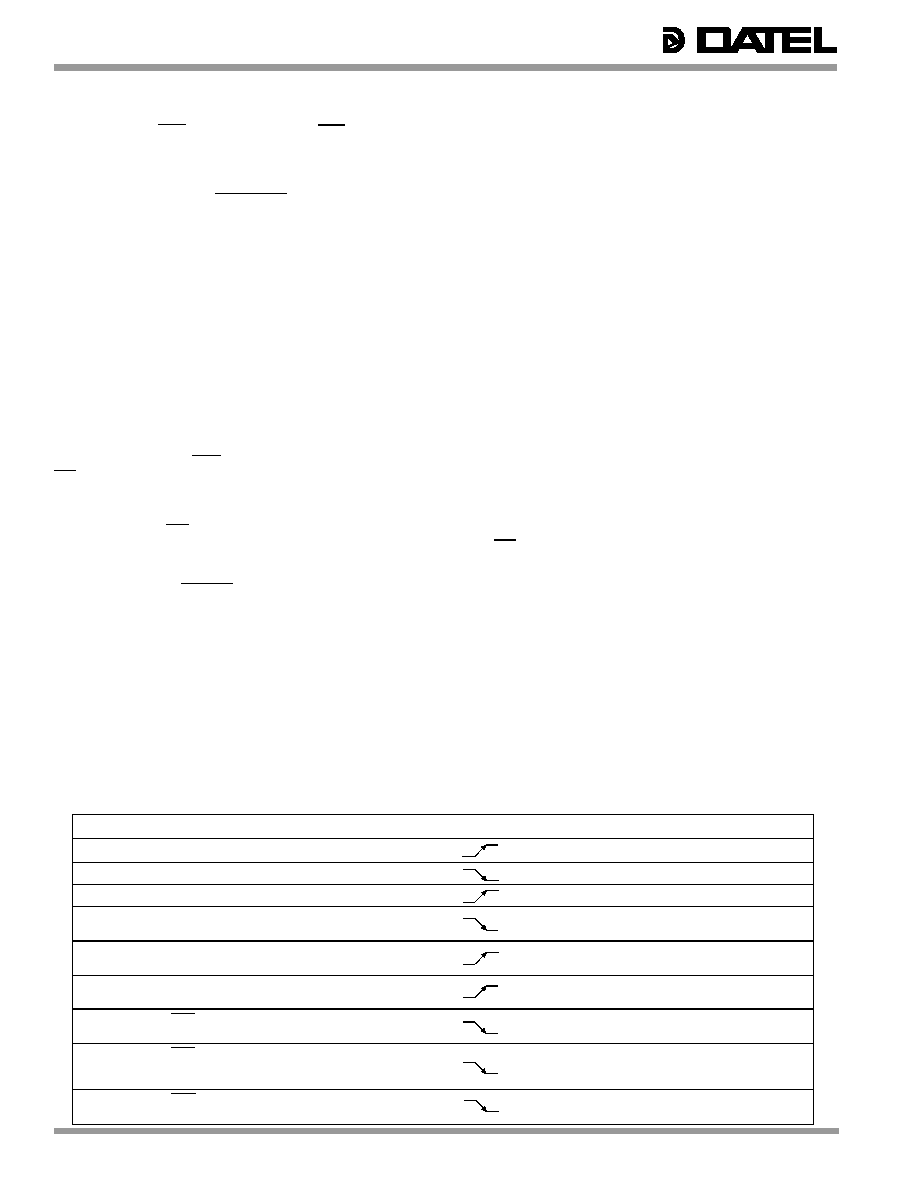
ADS-932
Æ
Æ
4
DELAY
PIN
TRANSITION
MIN.
TYP.
MAX.
UNITS
Direct mode to FIFO enabled
8
≠
10
20
ns
FIFO enabled to direct mode
8
≠
10
20
ns
FIFO READ to output data valid
9
≠
≠
40
ns
FIFO READ to status update when changing
from <half full (1 word) to empty
9
≠
≠
20
ns
FIFO READ to status update when changing
from
half full (8 words) to <half full (7 words)
9
≠
≠
110
ns
FIFO READ to status update when changing
from full (16 words) to
half full (15 words)
9
≠
≠
190
ns
Falling edge of EOC to status update when writing
first word into empty FIFO
32
≠
≠
190
ns
Falling edge of EOC to status update when
changing FIFO from <half full (7 words) to
32
≠
≠
110
ns
half full (8 words)
Falling edge of EOC to status update when filling
FIFO with 16th word
32
≠
≠
28
ns
When the FIFO is initially empty, digital data from the first
conversion (the "oldest" data) appears at the output of the
FIFO immediately after the first conversion has been
completed and remains there until the FIFO is read.
If the output three-state register has been enabled (logic "0"
applied to pin 34), data from the first conversion will appear at
the output of the ADS-932. Attempting to write a 17th word to
a full FIFO will result in that data, and any subsequent
conversion data, being lost.
Once the FIFO is full (indicated by FSTAT1 and FSTAT2 both
equal to "1"), it can be read by dropping the FIFO READ line
(pin 9) to a logic "0" and then applying a series of 15 rising
edges to the read line. Since the first data word is already
present at the FIFO output, the first read command (the first
rising edge applied to FIFO READ) will bring data from the
second conversion to the output. Each subsequent read
command/rising edge brings the next word to the output lines.
After the 15th rising edge brings the 16th data word to the
FIFO output, the subsequent falling edge on READ will update
the status outputs (after a 20ns maximum delay) to FSTAT1 =
0, FSTAT2 = 1 indicating that the FIFO is empty.
If a read command is issued after the FIFO empties, the last
word (the 16th conversion) will remain present at the outputs.
FIFO Reset Feature
At any time, the FIFO can be reset to an empty state by putting
the ADS-932 into its "direct" mode (logic "0" applied to pin 8,
FIFO/DIR) and also applying a logic "0" to the FIFO READ line
(pin 9). The empty status of the FIFO will be indicated by
FSTAT1 going to a "0" and FSTAT2 going to a "1". The status
outputs change 40ns after applying the control signals.
FIFO Status, FSTAT1 and FSTAT2
Monitor the status of the data in the FIFO by reading the two
status pins, FSTAT1 (pin 10) and FSTAT2 (pin 11).
CONTENTS
FSTAT1
FSTAT2
Empty (0 words)
0
1
<half full (<8 words)
0
0
half-full or more (
8 words)
1
0
Full (16 words)
1
1
Table 1. FIFO Delays
1
0
0
1
1
0
0
1
0
1
0
1
0
1
1
0
1
0
6. Do not enable/disable or complement the output bits or
read from the FIFO during the conversion process (from the
rising edge of EOC to the falling edge of EOC).
7. The OVERFLOW bit (pin 33) switches from 0 to 1 when the
input voltage exceeds that which produces an output of all
1's or when the input equals or exceeds the voltage that
produces all 0's. When COMP BITS is activated, the above
conditions are reversed.
8. When configuring the ADS-932 for the unipolar mode, Pin 1
(+3.2V REF.) should be connected to Pin 2 (Unipolar)
through a non-inverting op-amp. For precision DC applica-
tions an OP-07 type amplifier is recommended, while AC
applications requiring the lowest level of harmonic distor-
tion should consider the AD9631.
When configuring the ADS-932 for the bipolar mode, Pin 2
(Unipolar) should be physically disconnected from the
surrounding circuitry. This will help prevent noise from
coupling into the A/D.
INTERNAL FIFO OPERATION
The ADS-932 contains an internal, user-initiated, 18-bit, 16-
word FIFO memory. Each word in the FIFO contains the 16
data bits as well as the MSB and overflow bits. Pins 8 (FIFO/
DIR) and 9 (FIFO READ) control the FIFO's operation. The
FIFO's status can be monitored by reading pins 10 (FSTAT1)
and 11 (FSTAT2).
When pin 8 (FIFO/DIR) has a logic "1" applied, the FIFO is
inserted into the digital data path. When pin 8 has a logic "0"
applied, the FIFO is transparent and the output data goes
directly to the output three-state register (whose operation is
controlled by pin 34 (ENABLE)). Read and write commands to
the FIFO are ignored when the ADS-932 is operated in the
"direct" mode. It takes a maximum of 20ns to switch the FIFO
in or out of the ADS-932's digital data path.
FIFO Write and Read Modes
Once the FIFO has been enabled (pin 8 high), digital data is
automatically written to it, regardless of the status of FIFO
READ (pin 9). Assuming the FIFO is initially empty, it will
accept data (18-bit words) from the next 16 consecutive A/D
conversions. As a precaution, pin 9 (which controls the FIFO's
READ function) should not be low when data is first written to
an empty FIFO.
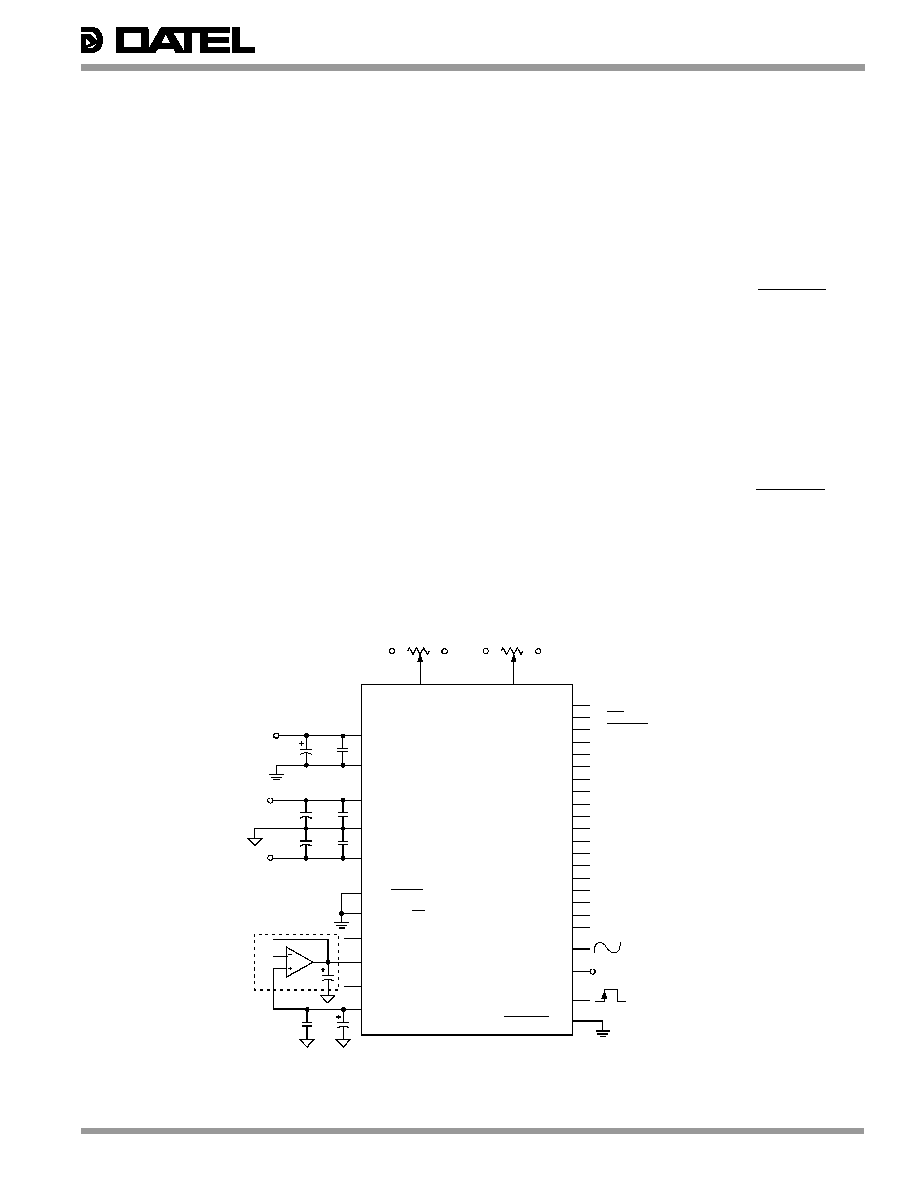
ADS-932
Æ
Æ
5
12) so that the converter is continuously converting.
2. For unipolar or bipolar zero/offset adjust, apply ≠42µV to the
ANALOG INPUT (pin 3).
3. For bipolar inputs, adjust the offset potentiometer until the
code flickers between 1000 0000 0000 0000 and 0111 1111
1111 1111 with pin 35 tied high (complementary offset
binary) or between 0111 1111 1111 1111 and 1000 0000
0000 0000 with pin 35 tied low (offset binary).
For unipolar inputs, adjust the offset potentiometers until all
output bits are 0's and the LSB flickers between 0 and 1 with
Pin 35 tied high (straight binary) or until all bits are 1's and
the LSB flickers between 0 and 1 with pin 35 tied low
(complementary binary).
4. Two's complement coding requires using BIT 1 (MSB) (pin
29). With pin 35 tied low, adjust the trimpot until the output
code flickers between all 0's and all 1's.
Gain Adjust Procedure
1. Apply +2.749874V to the ANALOG INPUT (pin 3).
2. For bipolar inputs adjust the gain potentiometer until all
output bits are 0's and the LSB flickers between a 1 and 0
with pin 35 tied high (complementary offset binary) or until
all output bits are 1's and the LSB flickers between a 1 and
0 with pin 35 tied low (offset binary).
3. Two's complement coding requires using BIT 1 (MSB)
(pin 29). With pin 35 tied low, adjust the gain trimpot until
the output code flickers equally between 0111 1111 1111
1111 and 0111 1111 1111 1110.
CALIBRATION PROCEDURE
Connect the converter per Figure 2. Any offset/gain
calibration procedures should not be implemented until the
device is fully warmed up. To avoid interaction, adjust offset
before gain. The ranges of adjustment for the circuits in
Figure 2 are guaranteed to compensate for the ADS-932's
initial accuracy errors and may not be able to compensate for
additional system errors.
A/D converters are calibrated by positioning their digital
outputs exactly on the transition point between two adjacent
digital output codes. This is accomplished by connecting
LED's to the digital outputs and performing adjustments until
certain LED's "flicker" equally between on and off. Other
approaches employ digital comparators or microcontrollers to
detect when the outputs change from one code to the next.
For the ADS-932, offset adjusting is normally accomplished
when the analog input is 0 minus Ω LSB (≠42µV). See Table
2b for the proper bipolar output coding.
Gain adjusting is accomplished when the analog input is at
nominal full scale minus 1Ω LSB's (+2.749874V).
Note: Connect pin 5 to ANALOG GROUND (pin 4) for
operation without zero/offset adjustment. Connect pin 6 to pin
4 for operation without gain adjustment.
Zero/Offset Adjust Procedure
1. Apply a train of pulses to the START CONVERT input (pin
Figure 2. Bipolar Connection Diagram
ADS-932
20k
33
32
29
28
27
26
25
24
23
22
21
20
19
18
17
16
15
14
13
OVERFLOW
EOC
BIT 1 (MSB)
BIT 1 (MSB)
BIT2
BIT 3
BIT 4
BIT 5
BIT 6
BIT 7
BIT 8
BIT 9
BIT 10
BIT 11
BIT 12
BIT 13
BIT 14
BIT 15
BIT 16 (LSB)
ANALOG
GROUND
DIGITAL
GROUND
0.1µF
4.7µF
0.1µF
COMP. BITS
4.7µF
+3.2V
REF. OUT
FIFO READ
31
7, 30
35
1
9
+5V
DIGITAL
≠5V
+5V
OFFSET
ADJUST
GAIN
ADJUST
5
6
3
0.1µF
4.7µF
4, 36
37
0.1µF
4.7µF
38
+
+
20k
≠5V
+5V
≠5V
+5V ANALOG
12
START CONVERT
ANALOG INPUT
34
ENABLE
8
FIFO/DIR
10
FSTAT1
11
FSTAT2
+5V
+5V
+5V
≠5V
UNIPOLAR
CONNECT for UNIPOLAR MODE
2
6.8µF




